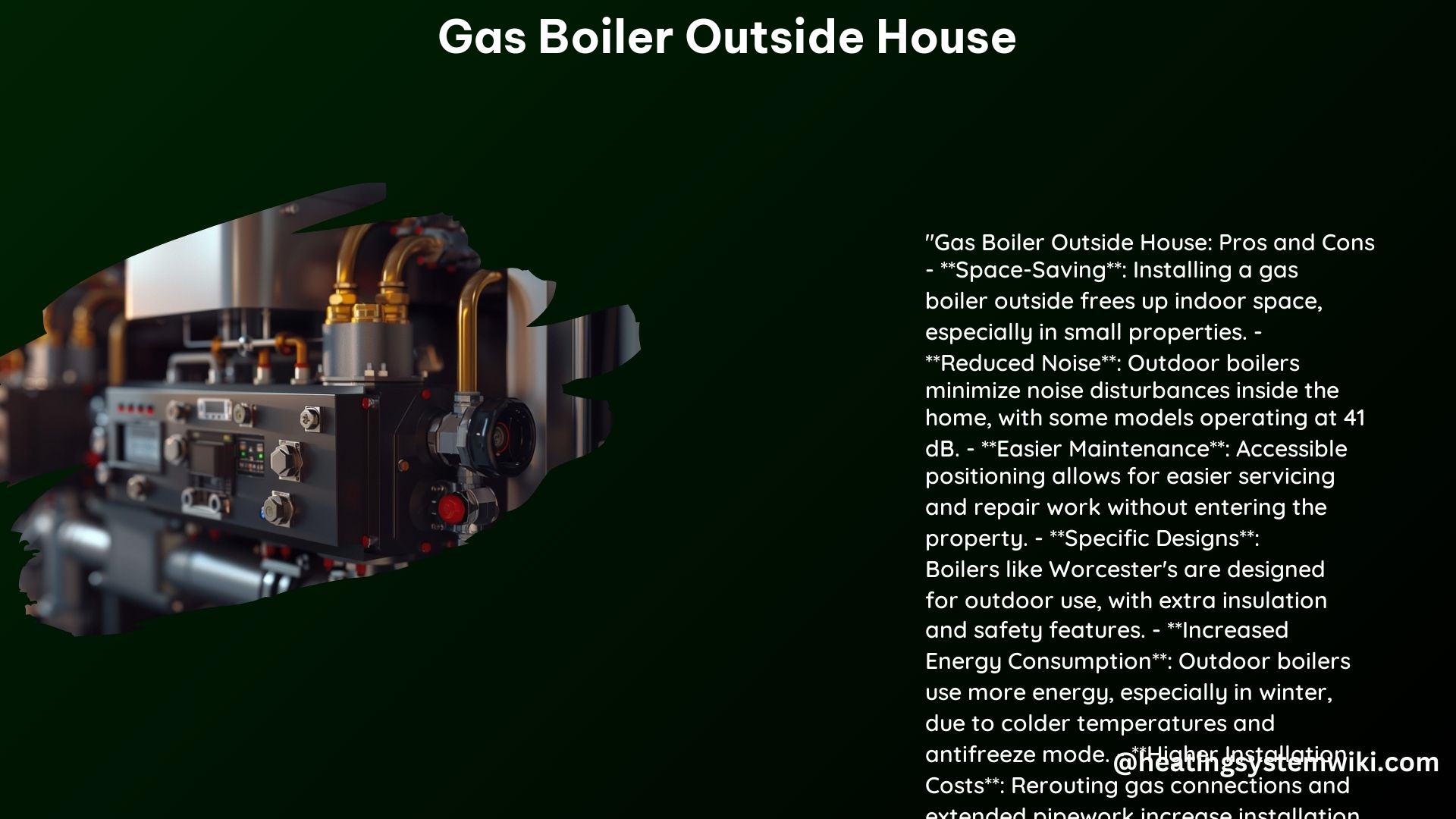Installing a gas boiler outside your house can be a practical and space-saving solution, especially when dealing with limited indoor space or aiming to reduce noise levels within your home. This comprehensive guide will delve into the benefits, safety features, technical specifications, and installation considerations for an outdoor gas boiler.
Benefits of Installing an Outdoor Gas Boiler
-
Space-Saving Solution: Outdoor boilers can free up valuable indoor space, making them an ideal choice for small properties or homes with limited space for a heating system. The average dimensions of an outdoor gas boiler range from 600mm (W) x 850mm (H) x 600mm (D) to 800mm (W) x 1200mm (H) x 700mm (D), depending on the model and manufacturer.
-
Reduced Noise Levels: By installing a boiler outdoors, you can significantly reduce noise disturbances inside your home. Outdoor boilers are designed with advanced sound-dampening features, such as insulation and noise-reducing enclosures, to minimize the impact on your living environment. The average noise level of an outdoor gas boiler ranges from 45 dB(A) to 55 dB(A), which is comparable to the sound of a quiet conversation.
-
Easier Maintenance Access: Outdoor boiler installations offer easier servicing and repair work without the need to enter the property, reducing disruption and ensuring a cleaner environment during maintenance procedures. This can be particularly beneficial for homeowners who prefer to minimize the impact on their daily routines.
Safety Features and Considerations

-
Building Regulations Compliance: Ensure that the outdoor boiler installation complies with all relevant building regulations and safety standards, such as the Gas Safety (Installation and Use) Regulations 1998 in the UK. This may include requirements for ventilation, clearances, and safety devices.
-
Weather Protection: Outdoor boilers need to be protected from weather conditions, such as rain and extreme temperatures, to maintain their functionality and efficiency. Manufacturers often provide weatherproof enclosures or housings specifically designed for outdoor installation, with features like waterproof seals, UV-resistant materials, and insulation to withstand the elements.
-
Antifreeze Mode: In colder climates, an outdoor boiler may need to activate its antifreeze mode more frequently to prevent freezing, which can result in increased gas consumption. The average outdoor boiler’s antifreeze mode can activate at temperatures below 5°C (41°F), with the boiler consuming an additional 5-10% of gas to maintain the necessary operating temperature.
-
Regular Servicing: Regular servicing by a professional Gas Safe registered engineer is crucial to ensure the optimal performance and longevity of an outdoor gas boiler. Recommended service intervals typically range from 12 to 24 months, depending on the manufacturer’s guidelines and the boiler’s usage patterns.
Technical Specifications and Installation
-
Specifically Designed Outdoor Boilers: There are boilers designed specifically for outdoor installation, such as the Worcester Greenstar Lifestyle CDi Outdoor range, which include extra insulation, weatherproof enclosures, and enhanced safety features. These boilers are typically rated for outdoor use and have an IP (Ingress Protection) rating of at least IP24 to withstand the elements.
-
Installation Costs: Installation costs for outdoor boilers can be higher compared to indoor models due to additional insulation, rerouting of gas connections, and extended pipework. The average cost of installing an outdoor gas boiler, including the unit and labor, can range from £3,000 to £5,000 in the UK, depending on the complexity of the installation and the specific requirements of the property.
-
Clearance and Ventilation: Ensure adequate clearance around the boiler for proper ventilation, servicing, and compliance with local regulations and guidelines. Typical clearance requirements for outdoor gas boilers include a minimum of 300mm (12 inches) on all sides and 1 meter (3.3 feet) above the boiler for maintenance access.
DIY Considerations
-
Consult a Gas Safe Engineer: It is essential to consult a Gas Safe registered installer for proper guidance on installing an outdoor gas boiler, ensuring safety and optimal performance. Attempting a DIY installation without the necessary expertise can be dangerous and may void the manufacturer’s warranty.
-
Follow Manufacturer’s Guidelines: Ensure that the installation follows the manufacturer’s guidelines and building regulations to avoid any potential hazards or inefficiencies. Failure to adhere to the manufacturer’s instructions may result in safety issues, reduced efficiency, and potential voiding of the warranty.
References
- Boiler Central. (2023, December 5). Outside Boilers and Is Installing an External Boiler Good or Bad? Retrieved from https://www.boilercentral.com/boiler-advice/outside-boiler-install/
- Reddit. (2023, December 12). Boiler outside. Retrieved from https://www.reddit.com/r/FirstTimeHomeBuyer/comments/18gh2du/boiler_outside/
- Duffy Heating. (2022, May 19). Are external boilers a good choice for homeowners? Retrieved from https://www.duffyheating.ie/blog/are-external-boilers-a-good-choice-for-homeowners/
- iHeat. (2023, November 13). Is Installing a Boiler Outside a Bad Idea? Expert Insights. Retrieved from https://iheat.co.uk/boiler-help/boiler-outside-bad-idea
- Mumsnet. (2017, September 3). Boiler outside anyone? Retrieved from https://www.mumsnet.com/talk/property/3023543-Boiler-outside-anyone
